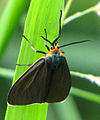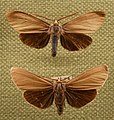| Virginia ctenucha | |
|---|---|

| |
| Adult | |

| |
| Larva | |
| Scientific classification | |
| Domain: | Eukaryota |
| Kingdom: | Animalia |
| Phylum: | Arthropoda |
| Class: | Insecta |
| Order: | Lepidoptera |
| Superfamily: | Noctuoidea |
| Family: | Erebidae |
| Subfamily: | Arctiinae |
| Genus: | Ctenucha |
| Species: | C. virginica |
| Binomial name | |
| Ctenucha virginica Esper, 1794 | |
| Synonyms | |
| |
Ctenucha virginica, the Virginia ctenucha, is a moth of the family Erebidae. The species was first described by Eugenius Johann Christoph Esper in 1794.
Morphology
The wingspan ranges from 40–50 millimetres (1.6–2.0 in). The wing color varies from black to olive brown. The body is a metallic blue green. The head is yellow orange, with feathery antennae. The caterpillar (about 20–25 mm) has multiple tufts of white and yellow hair. It undergoes metamorphosis in May–August.
Range
It is endemic to eastern North America, from Newfoundland south to Virginia. According to the University of Alberta, there has been a westward expansion in the last 60 years as it has reached the Canadian Rockies and is now found in all Canadian provinces.
Food plants
Larvae feed on a variety of host plants including various grasses, irises, and sedges. Adults drink nectar from flowers including goldenrod.
Images
Similar species
- Cisseps fulvicollis – yellow-collared scape moth
- Harrisina americana – grapeleaf skeletonizer
References
- ^ Cotinis (12 July 2020). "Species Ctenucha virginica - Virginia Ctenucha - Hodges#8262". BugGuide. Retrieved November 10, 2020.
- Patch, Edith (1921). A Meadow Caterpillar. University of Maine.
- Schmidt, B. C. & Robinson, E. "Species Details Ctenucha virginica". University of Alberta Museums. E.H. Strickland Entomological Museum. Retrieved 10 November 2020.
External links
- Lotts, Kelly & Naberhaus, Thomas (2017). "Virginia Ctenucha Ctenucha virginica (Esper, 1794)". Butterflies and Moths of North America. Retrieved November 10, 2020.
| Taxon identifiers | |
|---|---|
| Ctenucha virginica |
|



